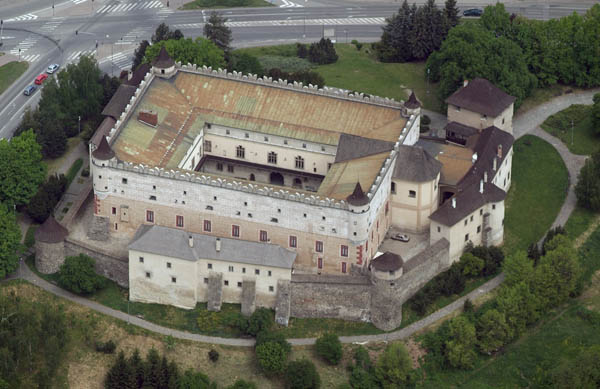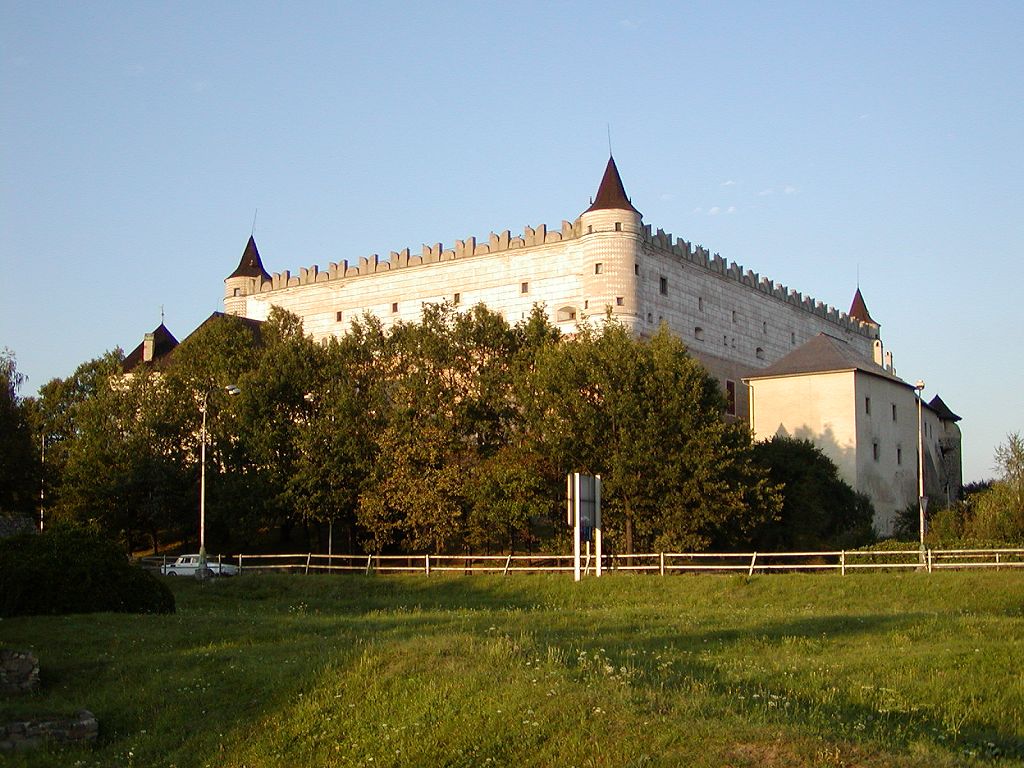|
Armored Train Hurban
The Armored train Hurban was an armored train used during World War II, during the Slovak National Uprising. The Hurban was constructed on September 25, 1944, in the Railway Manufactory in Zvolen, Slovakia, and was the last armored train used in the Slovak National Uprising. A replica is displayed as a monument in a park next to the Zvolen Castle, castle in Zvolen, and an original preserved machine gun carriage is at the Museum of the Slovak National Uprising in Banská Bystrica#Museums, Banská Bystrica.Images from Google maps are availablhere Combat history The commander of the train was Captain J. Kukliš, and his assistant was Lt. J. Belko, together commanding a crew of 71 men. Hurban operated in the Brezno – Červená Skala area against the 18th SS Volunteer Panzergrenadier Division Horst Wessel, 18th division SS Horst Wessel and from October 23–24, 1944, was the main factor in the fight for the upper flow of the Hron river. Despite suffering a damaged engine, it repul ... [...More Info...] [...Related Items...] OR: [Wikipedia] [Google] [Baidu] |
Zvolen Castle
Zvolen Castle ( sk, Zvolenský zámok or incorrectly , hu, zólyomi vár) is a medieval castle located on a hill near the center of Zvolen, in central Slovakia. It was a part of the Kingdom of Hungary from the 1370's until the Treaty of Trianon in 1920. The original seat of the region was above the confluence of Slatina and Hron rivers on a steep cliff in a castle from the 12th century, known today as Pustý hrad (meaning "Deserted castle"). Its difficult access had consequence in relocation of the seat to the new-built Zvolen castle, which was ordered by Louis I the Great as a hunting residence of Hungarian kings. The future queen regnant Mary of Hungary and emperor Sigismund celebrated their wedding there in 1385. Gothic architecture of the castle built between 1360 and 1382 was inspired by Italian castles of the fourteenth century. Italian masons also contributed to a Renaissance reconstruction in 1548. The last major reconstruction occurred in 1784, when the chapel was r ... [...More Info...] [...Related Items...] OR: [Wikipedia] [Google] [Baidu] |
Brezno
Brezno (; 1927–1948 ''Brezno nad Hronom'', german: Bries or ''Briesen'', hu, Breznóbánya) is a town in central Slovakia with a population of around 21,000. Geography Brezno is located within the Geomorphological division of Slovakia, Horehronské podolie basin. Brezno lies between the Low Tatras mountain range and the Slovak Ore Mountains, both of which belong to the Inner Western Carpathians. The town is situated on the right bank of the River Hron, which flows through town from the east, in the direction of the city of Banská Bystrica, approximately west. The local climate in the basin is rather cold, with an annual average of and an annual precipitation of . History The area has been inhabited since prehistoric times, but the current town arose from an old Slovak settlement, next to which newly arrived German miners erected a typical market square in the early 13th century. The first written evidence of the town's existence is dated 1265 when King Béla IV of Hungary i ... [...More Info...] [...Related Items...] OR: [Wikipedia] [Google] [Baidu] |
Krajina Express
The Krajina Express ( sr, Крајина експрес) was an improvised armored train used by the Krajina Serb army during the Croatian War of Independence and the Bosnian War, from 1991 to 1995. The main battle in which the train became involved was the Siege of Bihać. The train's crew also performed in combat in the role of infantry. Background The improvisation of weapons was a common feature of all parties involved in the conflict during the breakdown of Yugoslavia in 1991. As a result, both Serbs and Croats assembled a number of armored trains. The Army of Republika Srpska operated a train that was ambushed and destroyed in October 1992 near the town of Gradačac by Bosnian Muslim forces that included a T-55 tank. The wreckage was later converted into a monument. The Croatian Army deployed a two-wagon armored train built in Split with a shield composed of two plates, one 8mm and the other 6mm thick, with a 30–50mm gap filled with sand between them. The vehicle was arm ... [...More Info...] [...Related Items...] OR: [Wikipedia] [Google] [Baidu] |
Armored Train Štefánik
The Armored train Štefánik was a military train used during World War II (during the Slovak National Uprising) in Slovakia. The building of the armored train started on September 4, 1944. It was finished on September 18, 1944, in a Railway Manufacture in Zvolen, Slovakia. It was equipped with: * the 75mm Czechoslovak mountain cannon vz. 15 in a cannon carriage * 2 37mm cannons in two tank carriages (LT vz. 35) * 10 7.92mm machineguns The commander of the train was Captain F. Adam, and his assistant was Lieutenant A. Tököly. The crew was 70 men. Its first action was on September 27, 1944, at the line Hronská Dúbrava – Kremnica. Near Stará Kremnička it was fighting against a German army advancing to Zvolen. When moving to Hronská Dúbrava, the German Luftwaffe destroyed the train's locomotive. After repair, it successfully fought at Žiar nad Hronom, Jalná and Hronská Dúbrava, from where it moved on October 18, 1944, to Krupina, where it fought against SS Schill ... [...More Info...] [...Related Items...] OR: [Wikipedia] [Google] [Baidu] |
Partisan (military)
A partisan is a member of an irregular military force formed to oppose control of an area by a foreign power or by an army of military occupation, occupation by some kind of insurgent activity. The term can apply to the field element of resistance movements. The most common use in present parlance in several languages refers to Resistance during World War II, occupation resistance fighters during World War II, especially under the Yugoslav Partisans, Yugoslav partisan leader Josip Broz Tito. History before 1939 The initial concept of partisan warfare involved the use of militia , troops raised from the local population in a war zone (or in some cases regular forces) who would operate behind enemy front line , lines to disrupt communications, seize posts or villages as forward-operating bases, ambush convoys, impose war taxes or contributions, raid logistical stockpiles, and compel enemy forces to disperse and protect their base of operations. George Satterfield has analyse ... [...More Info...] [...Related Items...] OR: [Wikipedia] [Google] [Baidu] |
Harmanec
Harmanec ( hu, Hermánd) is a village and municipality in Banská Bystrica District in the Banská Bystrica Region of central Slovakia. History The village first appears in historical records circa 1540. Geography The municipality lies at an altitude of 486 metres and covers an area of 7.757 km². It has a population Population typically refers to the number of people in a single area, whether it be a city or town, region, country, continent, or the world. Governments typically quantify the size of the resident population within their jurisdiction using a ... of about 918 people. Sights The village is located close to the Harmanec Cave. References External links * https://www.harmanec.sk/ Villages and municipalities in Banská Bystrica District {{BanskaBystrica-geo-stub ... [...More Info...] [...Related Items...] OR: [Wikipedia] [Google] [Baidu] |
Nazi Germany
Nazi Germany (lit. "National Socialist State"), ' (lit. "Nazi State") for short; also ' (lit. "National Socialist Germany") (officially known as the German Reich from 1933 until 1943, and the Greater German Reich from 1943 to 1945) was the German state between 1933 and 1945, when Adolf Hitler and the Nazi Party controlled the country, transforming it into a dictatorship. Under Hitler's rule, Germany quickly became a totalitarian state where nearly all aspects of life were controlled by the government. The Third Reich, meaning "Third Realm" or "Third Empire", alluded to the Nazi claim that Nazi Germany was the successor to the earlier Holy Roman Empire (800–1806) and German Empire (1871–1918). The Third Reich, which Hitler and the Nazis referred to as the Thousand-Year Reich, ended in May 1945 after just 12 years when the Allies defeated Germany, ending World War II in Europe. On 30 January 1933, Hitler was appointed chancellor of Germany, the head of gove ... [...More Info...] [...Related Items...] OR: [Wikipedia] [Google] [Baidu] |
Hron
The Hron ( sk, Hron; german: Gran; hu, Garam; la, Granus) is a long left tributary of the DanubePlán manažmentu povodňového rizikavčiastkovom povodí Hrona p. 38 and the second-longest river in . It flows from its source in the Low Tatra Mountains (below ) through central and southern Slovakia, emptying into the Danube near |
18th SS Volunteer Panzergrenadier Division Horst Wessel
The 18th SS Volunteer Panzer Grenadier Division "Horst Wessel" (german: 18. SS-Freiwilligen Panzergrenadier-Division "Horst Wessel")Official designation in German language as to „Bundesarchiv-Militärarchiv“ in Freiburg im Breisgau, stores of the Wehrmacht and Waffen-SS. was formed in 1944 around a cadre from the 1st SS Infantry Brigade and included mainly ethnic Germans (''Volksdeutsche'') from Hungary. The 1st battalion of about 1000 men was attached to SS Division Horst Wessel and sent to Galicia. It was used for "rear-security" duties until it was sent to the Eastern front, with the exception of one regiment that fought the Slovak National Uprising in August 1944. It later fought as a single unit in Hungary and in Czechoslovakia where it was destroyed. The Division was named after SA member Horst Wessel, known for being the author of the lyrics to the Nazi Party anthem, the ''Horst-Wessel-Lied'', and glorified by the Nazi regime as a martyr of the party's early years. ... [...More Info...] [...Related Items...] OR: [Wikipedia] [Google] [Baidu] |
Commander
Commander (commonly abbreviated as Cmdr.) is a common naval officer rank. Commander is also used as a rank or title in other formal organizations, including several police forces. In several countries this naval rank is termed frigate captain. Commander is also a generic term for an officer commanding any armed forces unit, for example "platoon commander", "brigade commander" and "squadron commander". In the police, terms such as "borough commander" and "incident commander" are used. Commander as a naval and air force rank Commander is a rank used in navies but is very rarely used as a rank in armies. The title, originally "master and commander", originated in the 18th century to describe naval officers who commanded ships of war too large to be commanded by a lieutenant but too small to warrant the assignment of a post-captain and (before about 1770) a sailing master; the commanding officer served as his own master. In practice, these were usually unrated sloops-of-war of no ... [...More Info...] [...Related Items...] OR: [Wikipedia] [Google] [Baidu] |
Zvolen
Zvolen (; hu, Zólyom; german: Altsohl) is a town in central Slovakia, situated on the confluence of Hron and Slatina rivers, close to Banská Bystrica. It is surrounded by Poľana mountain from the East, by Kremnické vrchy from the West and by Javorie and Štiavnické vrchy from the South. Zvolen is a seat of a county (Zvolen District). It is also an important transportation hub in Slovakia. Etymology The name is of Slovak (Slavic) origin meaning "the chosen one, splendid, excellent". The Hungarian ' and the German ' were derived from the Latinized form ' (earliest mention 1135). An adjective "Old" (german: Altsohl, sk, Starý Zvolen, la, Antiquum or Vetus Solium) distinguish Zvolen from Banská Bystrica (german: Sohl, Neusohl). History Zvolen has been inhabited since the Paleolithic. In the ninth century, a Slavic settlement (today the Môťová neighborhood) became a regional center of what is now central Slovakia. Zvolen remained the capital of Zólyom County unt ... [...More Info...] [...Related Items...] OR: [Wikipedia] [Google] [Baidu] |


